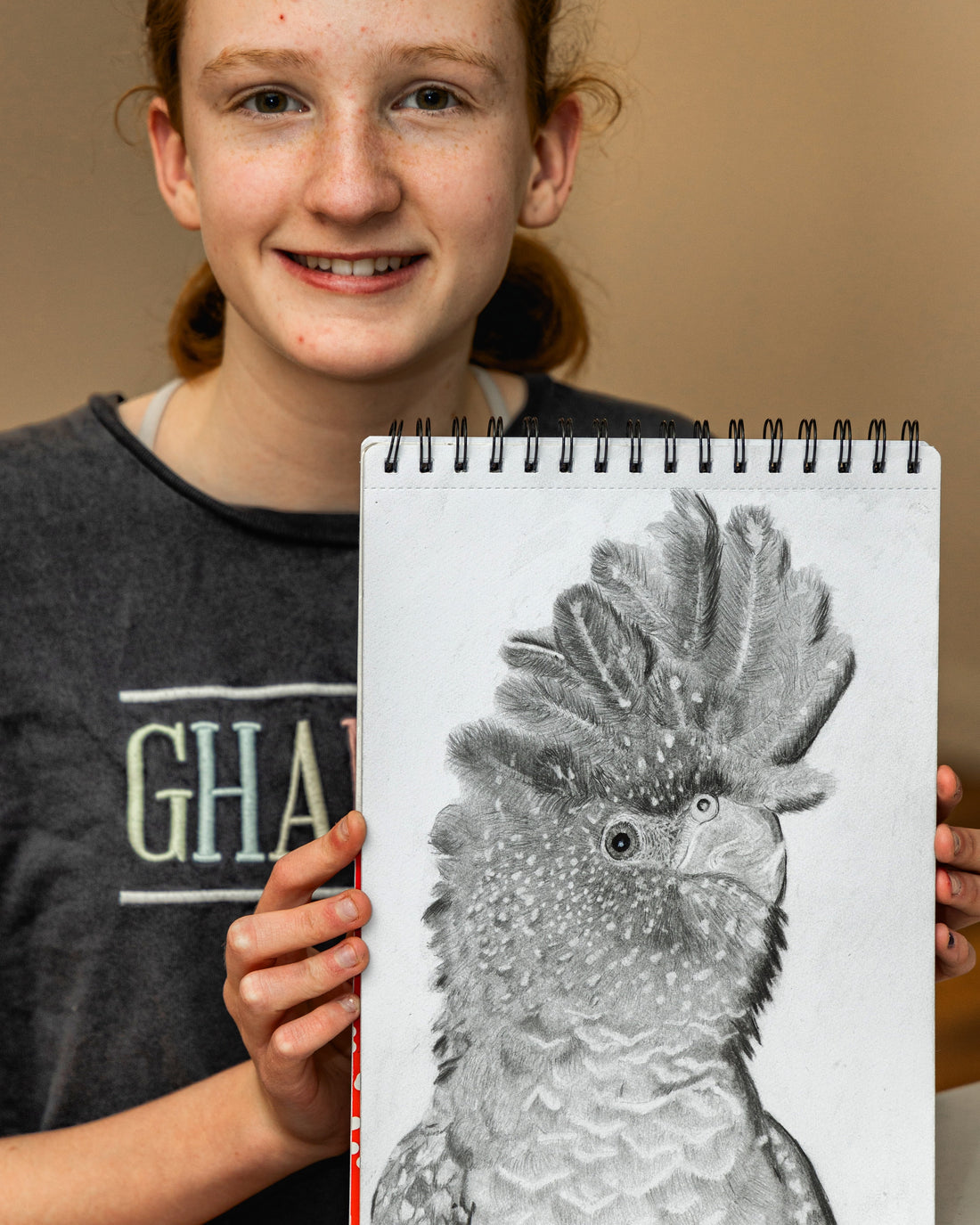
How kids’ drawing transforms when parents get involved (in the right way)
Share
Hey there! I’m Luke Lewis, founder of Luke’s Fine Arts, where I help artists of all ages build their drawing skills and grow in confidence—especially the youngest ones.
If you’ve ever wondered how your support as a parent can shape your child’s creativity, you’re in the right place. The truth is, even small shifts in the way you support your child can lead to massive leaps in their artistic development. And the best part? You don’t have to be an artist yourself to make a powerful impact.
In this blog, we’ll explore how to be an encouraging, empowering presence in your child’s art journey—without adding pressure or taking over. Let’s dive in!
What you’ll learn today
In this post, you’ll discover how thoughtful, low-pressure involvement can unlock creativity and joy in your child’s art practice. You’ll learn:
-
Why praising effort over outcomes fosters resilience and growth
-
How to ask questions that spark self-reflection and confidence
-
The power of letting kids choose what they draw
-
Why drawing alongside your child—even as a beginner—is more impactful than you think
-
How something as simple as printing a clear reference image can dramatically improve their artwork
Let’s get started by looking at the foundation of it all: encouragement.
The power of encouragement: how the right words can spark big progress
Every artist, young or old, wrestles with self-doubt at times. For kids, especially those just beginning their creative journey, the words they hear from you can shape how they view their abilities for years to come.
I remember a young student named Layla who was hesitant to start her drawing one day because she didn’t think it would “look good.” Her dad simply said, “Just have fun with it—I love seeing what you come up with.” That moment turned everything around. She relaxed, started drawing, and ended up creating something truly original—and she was proud of it.
Encouragement isn’t about false praise. It’s about believing in them—especially when they’re unsure of themselves. A few kind, specific words like “I can see how much time you spent on this part” or “That’s such a creative idea” can boost confidence and give them the courage to keep going, even when they hit a snag.
Let them choose what they want to draw
One of the simplest ways to encourage creativity? Let your child choose their own subject. When kids pick what they want to draw—whether it’s dragons, dogs, or their favourite cartoon character—they take ownership of their work.
As an art teacher, I often begin by selecting subjects for my students. This helps them build foundational skills—like proportions, shading, and observation—that are critical to artistic growth. But once those tools are in place, I give them free rein. And honestly? That’s when the magic really begins. Whether they want to try surrealism, experiment with abstraction, or bring a wild fantasy creature to life in a realism class—it’s absolutely welcome.
This balance of structure and freedom allows students to grow technically while still expressing their individuality.
Try this at home: Instead of saying, “Let’s draw a house today,” ask, “What do you feel like drawing?” You might be surprised where their imagination takes them!
Praise the effort, not the outcome: shift the focus to growth
It’s easy to look at a finished drawing and say, “That looks great!” But praising the final product alone can accidentally create pressure to always get it “right.”
Instead, celebrate the effort they put in. Comment on their persistence, their experimentation, or how they improved from last week.
For example:
-
“I love how you stuck with that tricky part—you really figured it out.”
-
“You tried something new today, and that’s awesome!”
Focussing on effort helps kids understand that it’s not about being perfect—it’s about learning, practising, and growing.
Why this works:
-
It encourages risk-taking. Kids aren’t afraid to try new things if they know they won’t be judged just on the result.
-
It builds resilience. Learning that mistakes are part of the process helps them bounce back faster.
-
It reinforces a growth mindset. They begin to see challenges as opportunities, not failures.
Let’s go deeper: why this shift matters
When a child hears “You’re so talented,” it may sound positive—but over time, it can create fear of losing that identity. They might begin avoiding harder projects because they’re afraid to fail and risk not seeming “talented.”
But when they hear “I noticed how carefully you worked on that background” or “I saw how you tried three different ways to draw the hand until you were happy with it,” they internalise the message that effort is valuable—and entirely within their control.
This fuels long-term growth. It teaches them to love the process of drawing, rather than tying their worth to a flawless result. And ultimately, this mindset produces stronger, more joyful, and more resilient artists.
Avoid the urge to “fix” their work—ask instead
When you see something “off” in your child’s drawing, it’s natural to want to step in and “help.” But that kind of help—reworking a line, fixing the proportions, or erasing something—can unintentionally send the message that their effort wasn’t good enough.
Instead, take a step back. Ask open-ended questions that help them think and reflect:
-
“What were you going for in this section?”
-
“Is there anything you’d like to change next time?”
-
“What’s your favourite part of this piece?”
As an art teacher, this is a balance I constantly have to navigate. My students come to me to improve their skills, which means offering constructive criticism—but it also means knowing when to hold back. If I correct every tiny flaw, I risk discouraging them or stifling their creative voice. Instead, I try to guide them with curiosity, asking questions and highlighting their progress just as much as their potential improvements.
This method allows children to reflect on their own choices, instead of relying on external correction. They start thinking critically and grow more confident in their decisions. More importantly, they feel seen, heard, and valued.
Over time, this practice builds independence and maturity in young artists. They learn to self-correct, experiment, and evolve—all key traits for any creative pursuit. So resist that urge to grab the pencil yourself. Instead, use your words to gently nudge them towards discovery.
Print out high-quality reference images (it really helps!)
One simple, often overlooked tip: print out clear, high-resolution reference images instead of relying on a phone or tablet screen.
Why? Here’s what happens when kids work from a physical reference:
-
They stay focussed—no distractions or screen flicking
-
They can study details more clearly, improving accuracy
-
It supports better posture and concentration
I once had a student who switched from using a small phone screen to a printed A4 photo of her subject. The improvement in her line work and shading was immediate—and she told me it just felt “easier to see.”
Quick tip:
Use your local library or a print shop if you don’t have access to a printer at home. Choose large, high-contrast images with good lighting to help bring out details.
Why drawing with your child makes a big impact
You don’t need to be a skilled artist to draw with your child—just willing to pick up a pencil. Sharing the drawing experience shows them that art is something worth doing together.
Even if your own sketch looks nothing like theirs, it’s the shared time that matters. You’re modelling curiosity, courage, and a love of learning.
Here’s what drawing side-by-side does:
-
It teaches patience and focus
-
It encourages conversation and bonding
-
It shows your child that mistakes are part of learning—for everyone
And best of all, it creates memories. Years later, they might not remember every drawing they made—but they’ll remember that you sat beside them and created something with them.
Key takeaways
✅ Encouragement over perfection
Praise effort and persistence, not just the final result. This builds confidence and a love for learning.
✅ Let kids choose their subjects
Giving them the freedom to pick what they draw fuels their creativity and ownership—even in structured environments.
✅ Ask, don’t fix
Engage with questions that promote reflection and growth instead of offering corrections. As a teacher or parent, this balance is powerful.
✅ Draw together
Join in the creative fun, regardless of your skill level. It deepens your connection and models artistic courage.
✅ Use high-quality references
Printed images help focus attention, improve accuracy, and remove digital distractions.
We’d love to see your child’s work!
Has your child been inspired lately? We’d love to celebrate their progress with you!
Send us a photo of their latest drawing, along with a short note about what they’re learning or enjoying about art. Email us at Lukesfinearts@gmail.com and let’s spotlight their creativity together!
